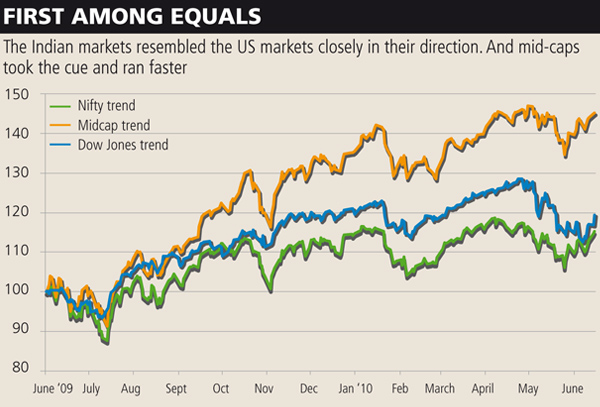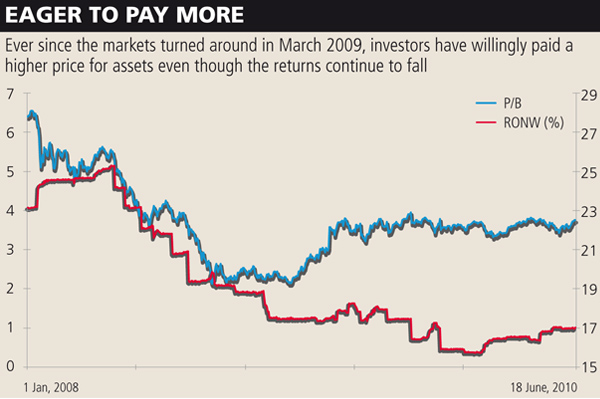
Taking Stock Of the Market
Given where the stock markets are, it is difficult for an average investor to decide whether to buy or sell. Here's making it easier
In the best of times, Shankar Sharma is the kind of man who can piss the eternal optimist off with his grim, almost Taleb-esque predictions. Over the last one year, the Nifty has moved up 15 percent while stocks of medium-sized companies rose three times as much. These are the kind of returns that have left investors in every other part of the world beady-eyed and glazed over with envy. Add to this the facts coming from the manufacturing economy: Automobile sales are robust and truck operators are back in the market looking to expand their fleets. These are indications of an economy on the trot.
The problem with Sharma is he’s the kind of grim Oracle you can’t wish away. He’s the man who called the debacle that was 2008 much earlier than anybody else did.
Now, Ridham Desai works two kilometres away from where Sharma operates out of. The head of equities business at Morgan Stanley looks every part a man who believes the market will gain 10 percent over the next couple of months. He says Indian stocks are valued just about right — in fact, there’s some steam left in prices — and that the Sensex will breach 19,000 by the end of the year.
Why? Because, while the recovery so far from the economic slowdown has been led by consumption surge, growth is now coming on the back of investments that add capacities. Not just that, capacity utilisation in India’s manufacturing and services companies is going up sharply. There are gains to be had from that as well. He doesn’t care much for the fires burning in Europe and other parts of the world. The problem is, like Sharma, Desai cannot be ignored at all. Last year, he argued the Sensex would move from 14,000 to 19,000. It almost, almost got there.
But the bigger problem is for regular investing folks. Do you align with the Sharma camp and simply focus on protecting your backside? Or do you go with Desai’s world view and hitch your wagon to the stars?
Portfolio Players
Let us face it. It is not easy taking a call on the markets today. This is one of those extraordinary times when even the professional investors go numb with paralysis. In the web of complex variables that dictate the day-to-day movement of the stock market, there is no one who can see beyond current volatility.
The markets have surprised all classes of investors too often in the last couple of years. Fund managers repeatedly failed to outperform broad-market indices and old correlation theories between risky assets and safe havens turned to dust. Investors who sold off and went into cash hopelessly watched as the market suddenly turned course and gave 50 percent returns in less than a year. Most people who made money did so serendipitously. But the sort of punishment that the actively bullish and bearish investors got for their decisions has made most of them wary of taking a decision again.
But given that inertia isn’t a legitimate investing strategy, we must look for intelligent clues from the domestic and foreign markets and try to decode what the volatility and the rigorous imprisonment of the stock market in a 10 percent range tell us.
The first place to start, of course, is capital flows. Foreign institutional investors (the here-today-gone-tomorrow guys) hold the key to the Indian markets. And second-guessing their behaviour isn’t easy. For instance, in May, FIIs moved out large sums of money—a net Rs. 9,910 crore —leading to a sudden fall in the market. Their immediate provocation: The US economy was showing signs of sputtering to life. And the Indian rupee had strengthened, thus converting to more dollars and making it unattractive to bring in funds into the market. The Sensex was hovering at around 16.000, not much more than where it started five months ago.
Yet in the following month, investor attendance was overwhelming at the Morgan Stanley annual investor summit in India. There was one big fly in the ointment though. Even the largest global fund managers were worried stiff about the European crisis and its impact on the world markets. “They are convinced as ever with the India story, but the global overhang still remains,” says Desai.
Now, there’s some evidence to suggest FIIs could end up as net sellers over the next few months. Emerging market investment expert Mark Mobius, who is the chief strategist for global investment firm Templeton, says that Indian equity valuations are not cheap compared to the historical averages. If investors like him follow this logic to stay away from the markets or even dilute their portfolio, the market would go back to being flattish till the year-end. Remember that stock prices have already factored in the expected earnings of corporate India in 2010-11. It is a compelling opportunity for FIIs to cash out now and return once valuations weaken a bit.
Besides, the rupee will maintain an uptrend over the long term. The economic growth differential between India and the developed world is as wide as ever. Further, the world’s rogue currency Renminbi has lost its de facto peg to the dollar and could appreciate. This, in turn, would have a knock-on effect on the rupee and push it up too.
Any such appreciation now will put off FIIs unless interest rates also harden to give them higher returns, say experts. “In an utter global panic or distress situation, many FIIs tend to follow the herd while selling risky assets in a wave of risk aversion. And if this wave hits the markets at the peak, every $4 billion or so can easily knock off 1,000 points or more from the Sensex,” says Devendra Nevgi, founder and principal partner at Delta Global Partners, a firm which manages the home office for clients in the US.
In the event of a huge FII sell-off, it will be up to the domestic financial institutions (DFIs) to display a much larger firepower to buoy up the markets. DFIs like Life Insurance Corporation (LIC) have committed to invest Rs 60,000 crore ($12 billion), about the same amount they invested into the equity market last year. If domestic demand and corporate earnings continue to appear robust, DFIs may well step in if the FIIs exit, as they did in May this year. But their investment can only arrest a fall. Whether they can contribute to a big upward move in the Sensex looks improbable.
Yearnings per Share
Last year, after the global recession, Indian companies posted a V-shaped recovery in earnings. For three consecutive quarters ending March 2010, earnings, when compared to a rather dismal 2008-9, seemed very good. Stock prices ran up across industry segments.
Around this time last year, we looked at the market and realised there was a lot of untapped value trapped in stocks of well-run companies. We knew that it was a rare opportunity that wouldn’t last long and hurried to reveal it to the readers. The 20 stocks that we ended up recommending across industry segments haven’t failed us: Our portfolio has risen 54% till date, grossly outperforming the benchmark Nifty index which rose by 15 percent.
Though the global economy has been spooked again, first by Dubai and later by the European contagion, corporate earnings growth will hold the key to valuations going forward. How are they likely to be?
According to a Morgan Stanley report, the broad market earnings (minus the energy sector) are almost at the peak of the previous cycle. The report says that earnings growth will likely to slow down in the coming quarters after a V-shaped recovery driven by a low base effect. However, the consensus estimates for earnings per share (EPS) for the Sensex stocks is at Rs. 1,105 for 2010-11, as compared to Rs. 897 for 2009-10, an increase of 23 percent. This increase is likely to be skewed by a jump in the heavyweight Reliance Industries’ fortunes, given the new income from gas. “The current stock prices have already factored in the FY11 earnings though some opportunities can be uncovered with a lot of research,” says Templeton’s Mobius.
The Bouquet of Choice
So where are the surprises going to come from? And how to choose the hidden gems? In the current context, three factors seem to deserve over-riding consideration: higher capacity utilisation, greater pricing power and investment-led growth.
Analysts say that in a sector like automobiles where demand is strong, companies like Tata Motors could benefit from both higher capacity utilisation and a bout of price increases. In industries like fast-moving consumer goods and commodities, the softness in petrochemical and energy prices is likely to keep input costs low. If they are able to hold on to prices, companies like Hindustan Unilever and Procter & Gamble could see a smart increase in earnings. And then, the substantial growth from investments already committed could bring the biggest winners. Desai expects that the big growth opportunity in infrastructure makes one take a look at even a company like Larsen and Toubro that is trading expensive.

“Today much of the growth has been consumption led. At some point, investment led growth has to set in across the board,” says Desai.
In such cases, the tipping point is usually achieved when the consumption curve has reached its highest point and begins a decline. That means companies are typically working at full capacity. Unless they reinvest in additional capacity, they won’t find growth.
Indian companies may well be preparing for the next cycle of investment. In the last one year, the average debt-to-equity ratio has come down from 0.7 percent in 2008-09 to 0.5 percent in 2010-11. That puts them at a comfortable position to borrow when the time for new investments comes. Already the cash hoard available with the top 1,000-odd Indian firms has ballooned to $61 billion.
Besides, capacity utilisation in key sectors like cement, steel and oil refining is again close to 90 percent. If the economy grows at 8 percent, some of the large companies could quickly exhaust the spare capacity. This will push them to build new manufacturing as is evident in the cement sector. Across a wide variety of firms, manufacturing capacities are being upped.
Automobile companies are also building new plants. Robust home sales are leading to demand growth for the products of companies like Asian Paints and Samsung (By the way, capacity increases has begun at both these firms). Reliance Industries is increasing its polyester manufacturing capacity. A recent report released by research agency Crisil says that investment growth will continue in India, despite the slowdown. The report estimates that across 11 key sectors such as power, telecom, oil, gas, cement, metals and automobiles, the projected project aggregate industrial capital expenditure is to be to the tune of Rs 10.5 lakh crore during 2009-10 to 2011-12.
Now, when the investment cycle begins to kick in, it would start to adversely impact the return on equity. The firms that comprise the elite Nifty 50 have generated an average return on equity of 17 percent, down from about 22 percent two years ago. But investors of 2009-10 didn’t allow that to deter them. The Price they paid for a given book value had only risen along with this fall in return on equity.
The World’s Mine Oyster
India’s trade deficit stands at 10 percent of GDP. And the country has heavily depended on consumption to spur growth. A large part of India’s deficit is financed from flows from the global financial markets. Any global imbalance could impact the Indian macro-environment pretty severely.
This is also why India is considered a high beta market. That is, Indian markets follow the trend in mature markets like the US in both directions, but move more violently than them. In technical parlance, there is a high correlation between international markets and the Indian market. On the basis of daily returns, the Indian markets have a correlation of 35 percent with the Dow Jones Index. And on the basis of value, at around 55 percent, the extent of correlation is even higher.
And over the last one year, the Dow Jones and the Nifty have developed a correlation of more than 90 percent. That is as “coupled” as they come.
Running for Cover
Clearly, any global shocks could spell trouble for the Indian markets.
This is a reality that even Indian investors have begun to recognise. And they’ve begun looking for better alternatives. High net worth investors are now particularly obsessed with safety—and the market is beginning to provide them just that.
The flood of structured products that has hit the market is a testimony to this trend. We are not talking of the infamous derivative contracts here, but structures designed for capital conservation. These products are offered to investors in the form of non-convertible debentures where the product is divided into equity and debt. Investors may not get the complete upside of the market, but in most cases, they do get their capital back. Till three months ago, this market accounted for around Rs. 5,000 crore. Much of the investment in this market had come two years ago and these structures had at the most managed to protect the capital of investors and generated very little return. But they do look attractive to jittery investors.
Many experts now expect the size of this opportunity to double over the next few months. Given the spectre of uncertainty in the market, firms like ABN Amro, Citicorp and Barclays are back with these products. Over the last month, Citicorp has managed to sell non-convertible debentures worth Rs. 1500 crore in the market.
At the same time, the demand for funds hawking an alternative asset strategy is gradually picking up. ICICI Prudential and HDFC Mutual Fund, the two biggest mutual fund houses, are on the verge of launching gold exchange-traded funds (ETFs). Milestone Capital Advisors, one of the largest domestic private equity funds, has recently launched Milestone Bullion, a portfolio management scheme that invests 40 percent in physical gold, 40 percent in physical silver and 30 percent in gold-linked capital protection structure. “Investors want assurance and they want to invest into asset classes that are different from equity. Nobody really knows where the equity markets are headed. So in such times, gold and silver get a preference,” says Navin Kumar, director, fund raising and head of investor relations at Milestone.
These are just some of the examples that show investors are exercising caution. The big question is should they be.
What Next?
In some sort of seasonal affective disorder, investors can allow themselves to be plunged into a mood of gloom. It is as big a crime in the market as reckless buying of stocks. The smarter thing, then, is to exercise caution without losing oneself to the inertia arising out of fear.

Some might call it a tad optimistic, but there is an alternative view gaining currency: That India might actually turn out to be a beneficiary of all the global uncertainty, as emerging markets become a safe haven for international investors. In such a situation, a huge amount of inflow can be expected into the Indian market.
In the past though, every time the world has landed in a crisis, money has flown back into US Treasuries and ended up strengthening the dollar. After all, that has always been seen as the only safe haven for global investors.
Yet for most part, the India story looks intact. The investment mood will come to reflect that sooner or later. This isn’t the time for excessive risk-taking, but neither is it too early for action. Forget calling the market as either bullish or bearish. The opportunity for the investor today is in those stable and safe stocks that are perfectly poised to benefit from each growth impulse coming from the economy. Often, such stocks turn out to be large caps, though that is not a rule.
So how should investors navigate the uncertain future? In our next story, we lay out some investment ideas and select stocks that we reckon could help you tread safely—and pocket some decent gains too.
(This story appears in the 16 July, 2010 issue of Forbes India. To visit our Archives, click here.)
-
 Dharm
DharmStill confused & not able to decide whether to invest further or not. Lets hope the fall as predicted by the SS does come & that too fast.
on Aug 14, 2010 -
 Preity
PreityToo good article..very useful and relevant in the current context!
on Jul 23, 2010 -
 azzamgvk
azzamgvkI have always looked for information that helps me in my work; this post has really good information, thank you.
on Jul 6, 2010

















